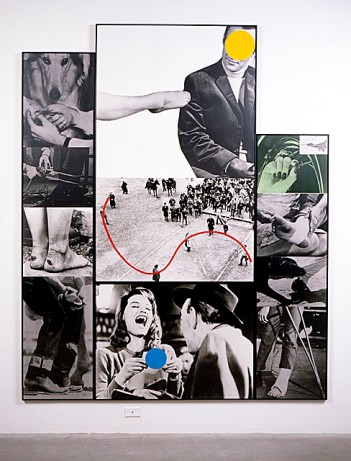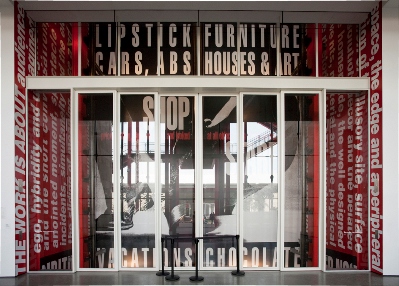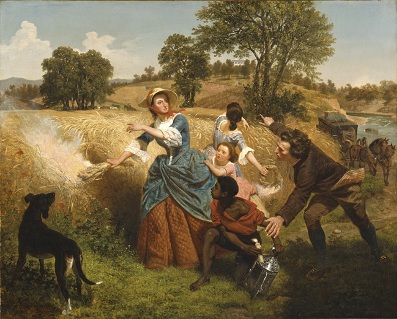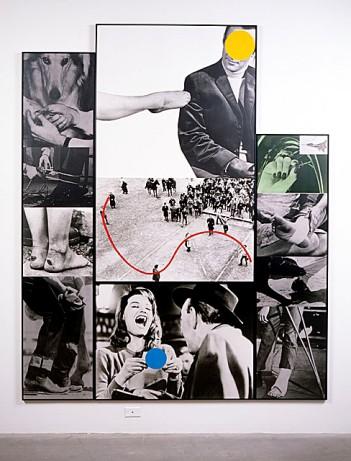The publicity around Michael Heizer's Levitated Mass got me thinking. Understandably, people sometimes mis-conjugate the verb, calling it “Levitating Mass”, which is sort of interesting, because the mass does appear to be in the midst of rising above the visitor as you pass under it. But the artist’s choice of past tense seems deliberate and pointed: the mass is, already, levitated. Accomplishing that was a major feat of engineering. Now the point is to experience it as such, and to contemplate the tension between those two words, one of which implies weighty noun-ness, the other, a continual act of weightless suspension.
Heizer’s monumental sculpture isn’t the only work of art at the museum titled with a deliberate choice of verb. In contrast to the past tense of Levitated Mass, here’s one that takes the form of simple present or even of a command: John Baldessari’s painting Heel.

John Baldessari, Heel, 1986, Modern and Contemporary Art Council Fund, © John Baldessari
"Heel" could be a noun, of course: one describing not only a portion of one’s foot, but also (this usage was less familiar to me) a disreputable person, usually a man. But taken as a verb, it means either “to follow”, to tilt to one side (as in a ship) or, less commonly, to dance using the back of one’s foot. The piece represents all possibilities equally.
To return to creative uses of the past tense, another good noun/verb title, and another work heavily involved with linguistics, is Barbara Kruger’s Untitled (Shafted).

Barbara Kruger, Untitled (Shafted), 2008, gift of Carole Bayer Sager, commissioned by the Los Angeles County Museum of Art for the opening of the Broad Contemporary Art Museum, © Barbara Kruger
To be shafted is to be cheated, swindled, or treated harshly, which one can assume, is part of her point, as one aspect of the piece is the critique of consumer culture and the forces that pressure us into craven commercial pursuits. (Shafted can also mean to push or propel with a pole.) The title is also, of course, a reference to a noun, the elevator shaft, where the piece is installed. But here, the surrounding cacophony of words suggests that the title may be, at least at the first level, a reference to a disempowered position, a state of having been violated in some way: we have been shafted.
I have another favorite use of an active verb, in a more traditional genre: Mrs. Schuyler Burning Her Wheat Fields on the Approach of the British.

Emanuel Gottlieb Leutze, Mrs. Schuyler Burning Her Wheat Fields on the Approach of the British, Bicentennial gift of Mr. and Mrs. J. M. Schaaf, Mr. and Mrs. William D. Witherspoon, Mr. and Mrs. Charles C. Shoemaker, and Jo Ann and Julian Ganz, Jr.
The title sticks with me, I think because there is something engaging in the combination of the formality of “Mrs. Schuyler” and the very active destruction described further on that carries through in the picture itself. “Sally Burning Her Wheat Fields” would feel more unhinged. Mrs. Schuyler, hair and dress perfectly in place, is enacting a very deliberate act of violence, burning her own property, whilst maintaining her composure. The gesture she makes with her left hand underscores her assurance, as if she needs to emphasize her own agency!
And speaking of mothers represented in a moment of dramatic action, take Tsukioka Yoshitoshi’s 1875 woodblock print Chiyokichi’s Mother Identifies Him and Solves a Case of Mistaken Identity.

Tsukioka Yoshitoshi, Chiyokichi’s Mother Identifies Him and Solves a Case of Mistaken Identity, 1875, Herbert R. Cole Collection
Talk about active verbs. Here is an exercise in present tense. Often, we use present tense to tell a story, to add drama – and Yoshitoshi does that in visual terms, putting the action of the story right in front of us as if it’s unfolding right now. Clearly, Chiyokichi’s mom has taken command of the scene. “Chiyokichi’s Mother Identified Him and Solved a Case of Mistaken Identity” would make a sleepy story but here she is, in the very moment, as if we are there in the immediate tense, in a way that art is uniquely placed to accomplish.
Amy Heibel



